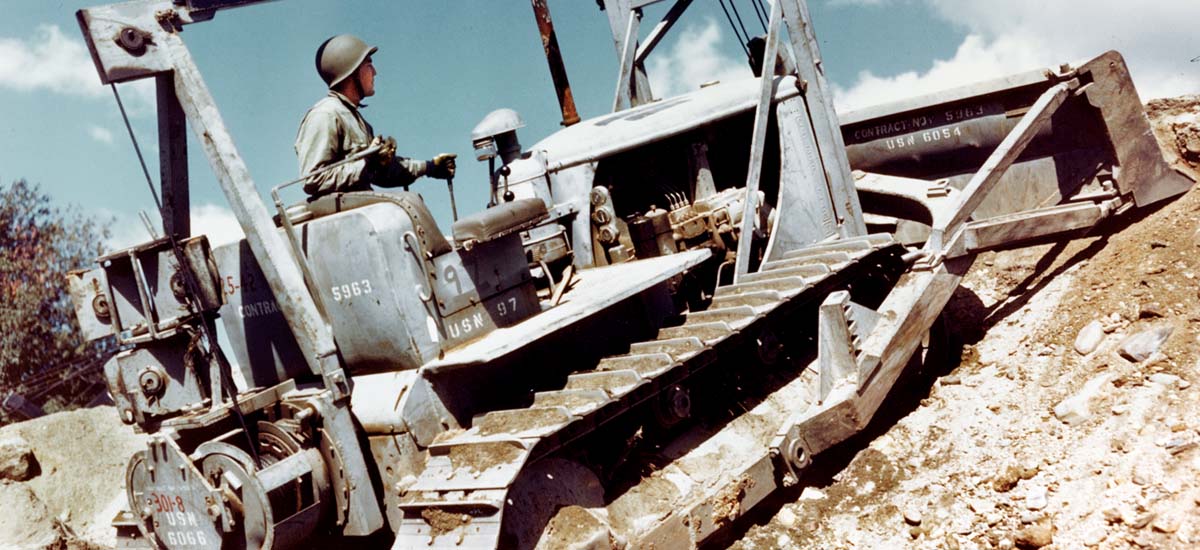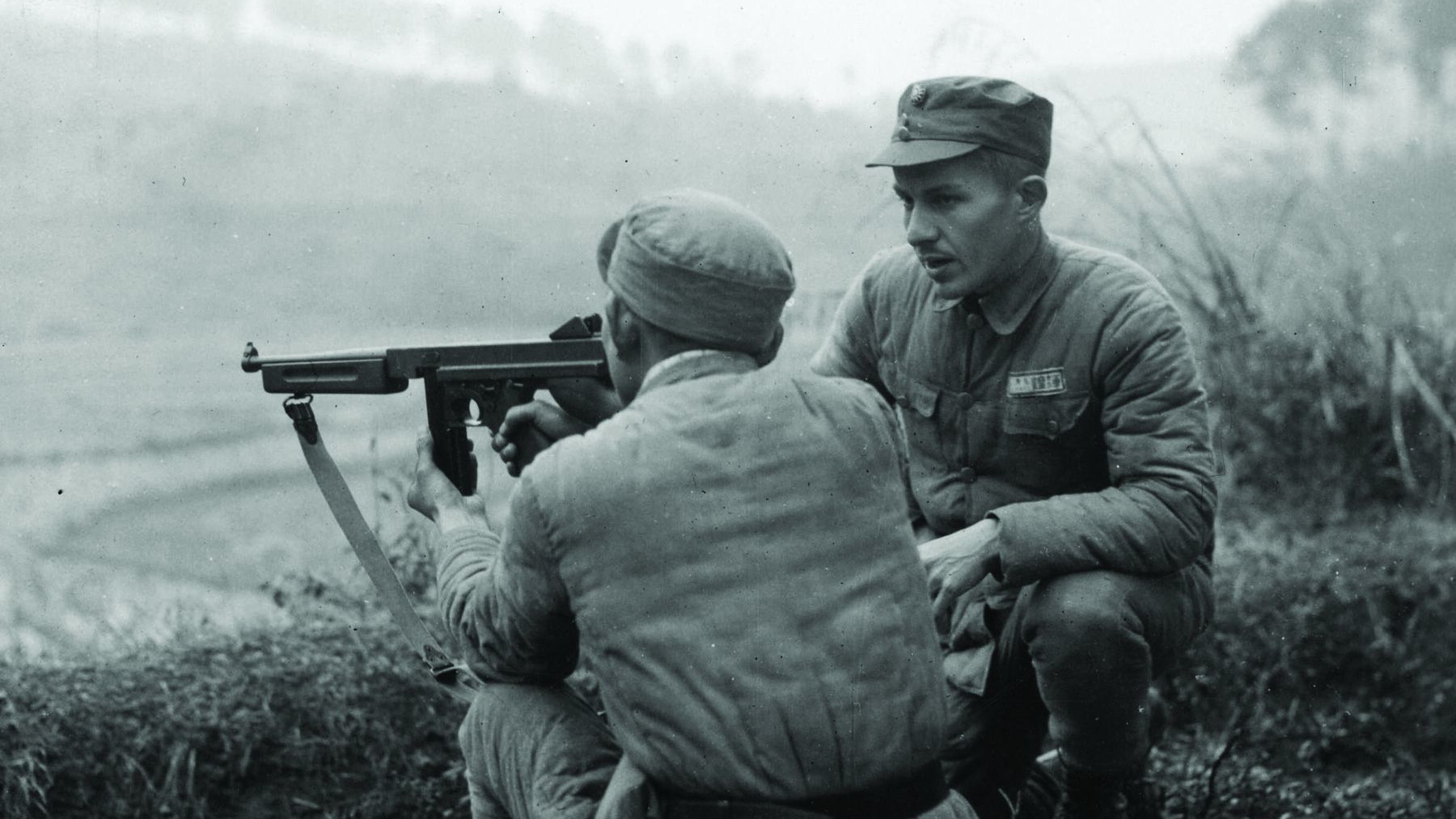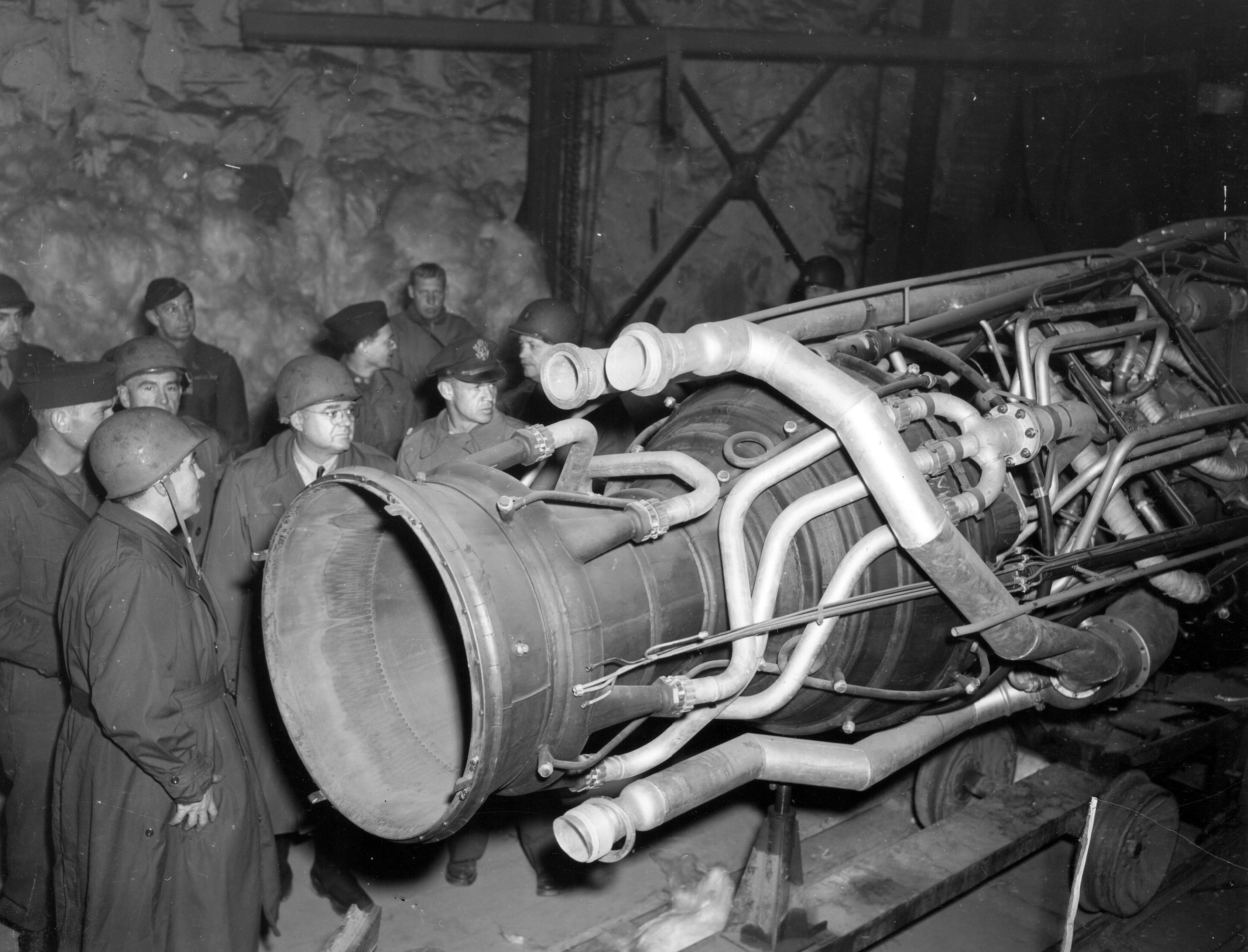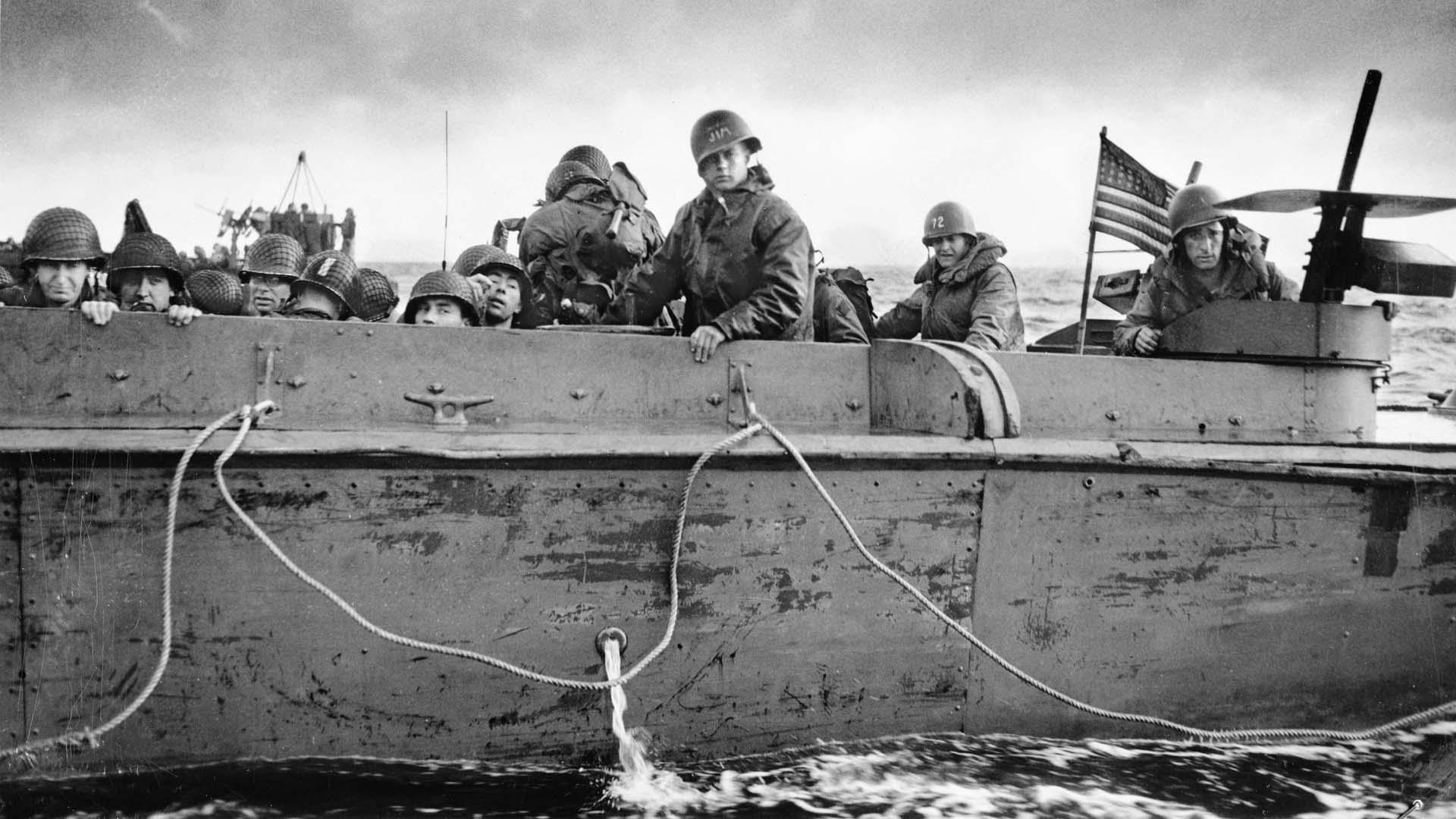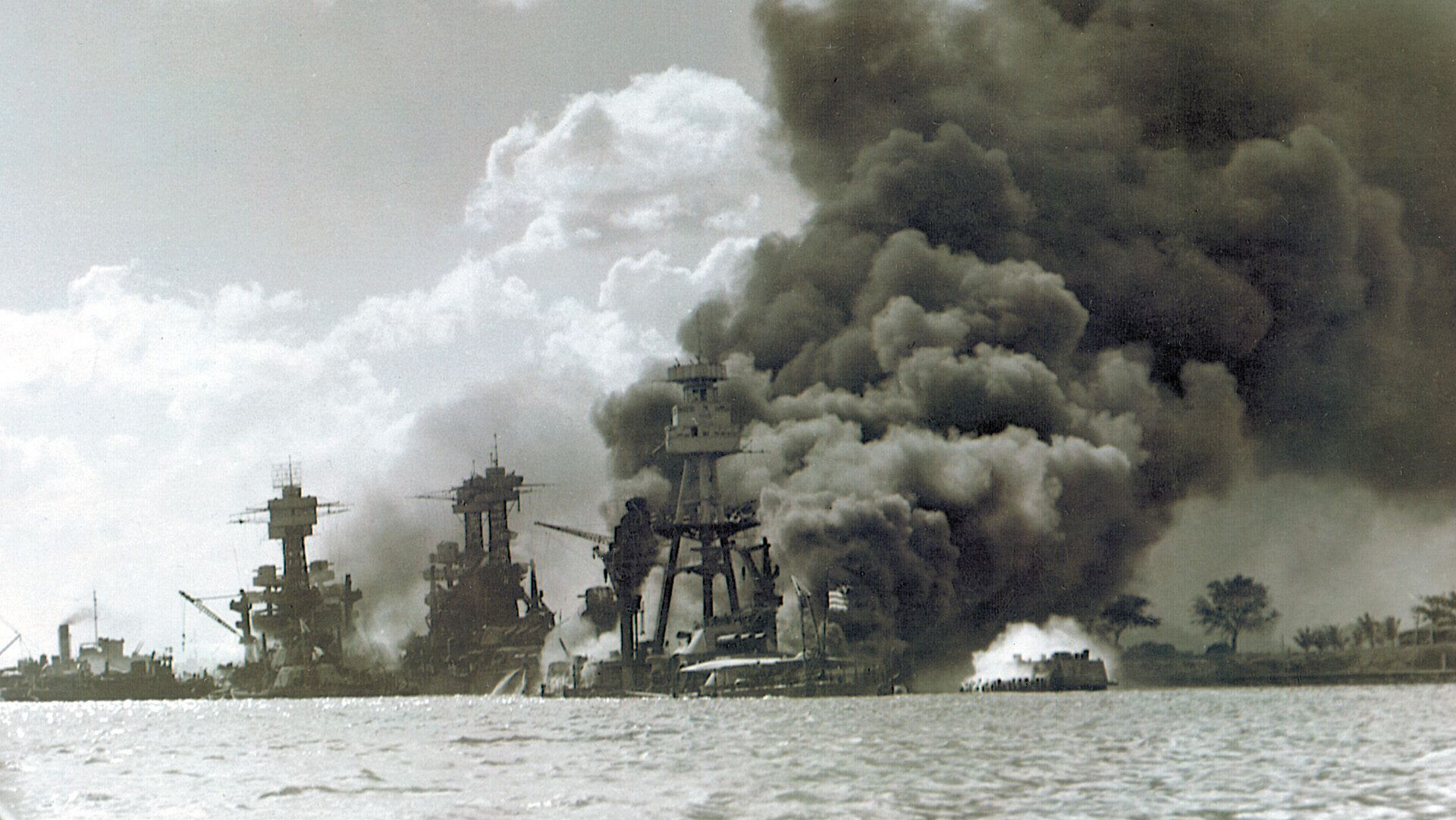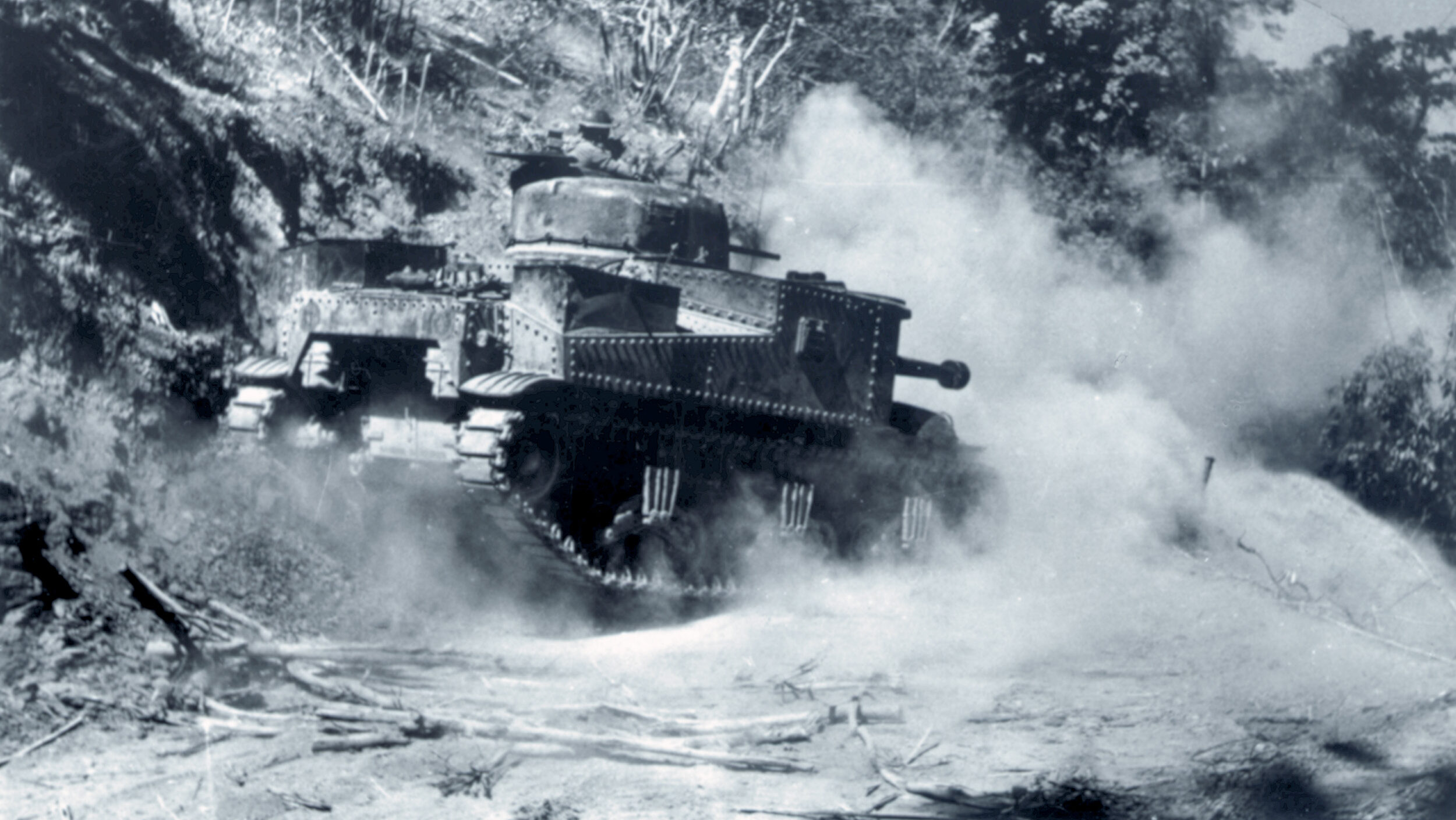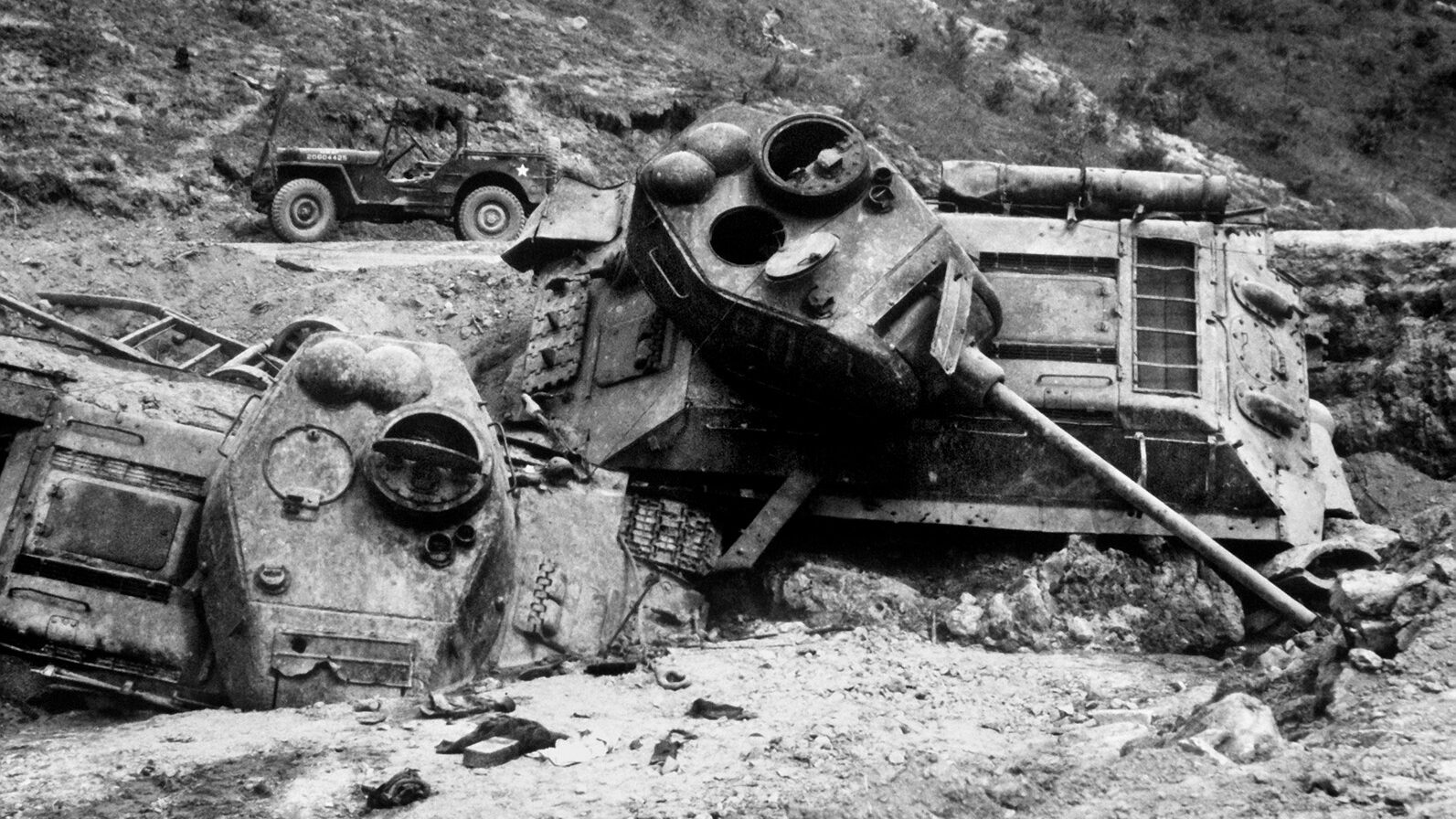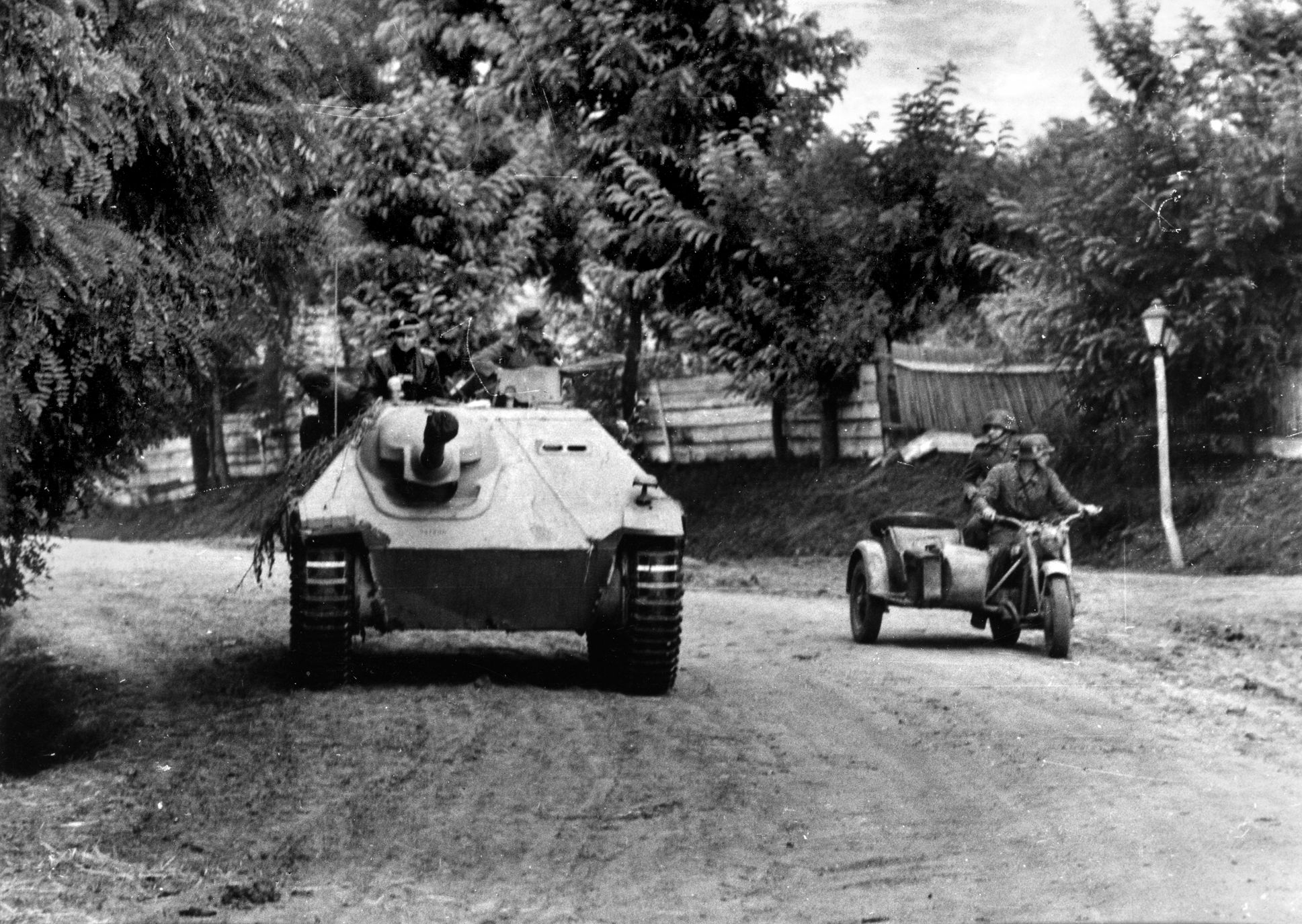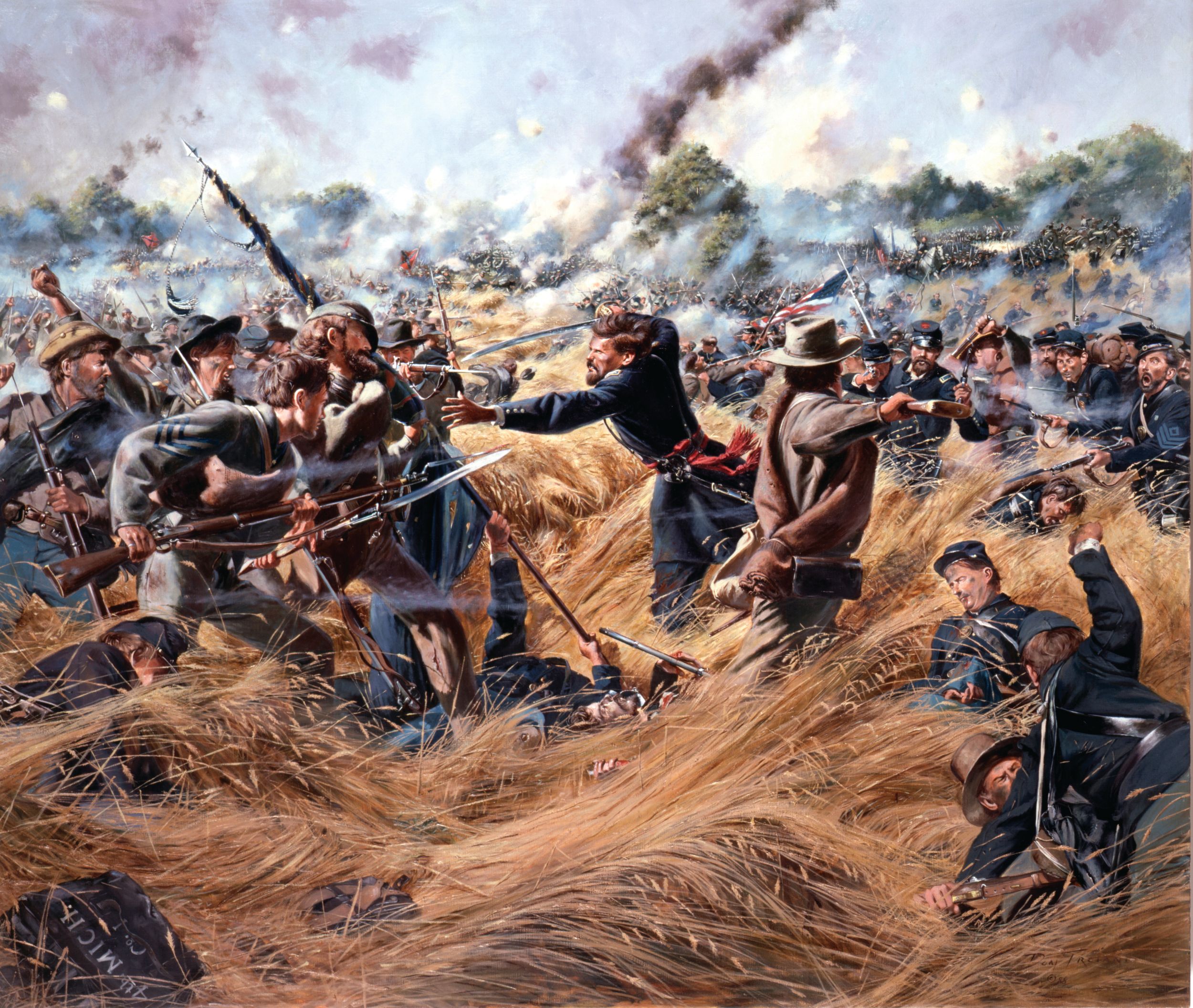By Glenn Barnett
As war clouds gathered over the vast Pacific Ocean in the late 1930s, the United States belatedly began to think of protecting the nation’s possessions of far-flung islands and atolls. Civilian contractors were hired to build runways, port facilities, barracks, fuel dumps, water towers, and fortifications in the Philippines, Guam, Midway, Wake, and especially Hawaii, the new home of the Pacific Fleet. The civilian workers relished the high-paying jobs especially after the lean early years of the Depression.
Military planners knew that they would be vulnerable if war broke out. By the “rules of war,” armed civilians could be considered guerrilla fighters and “legally” executed by the enemy. In the small circles of the military establishment in Washington, consideration was given to creating a construction corps within the Navy similar to the Army Corps of Engineers. Before December 1941, however, little was done.
Meanwhile, in the Atlantic in July 1941, the United States assumed responsibility for protecting Iceland to relieve the hard-pressed British. The call went out for civilian construction workers to beef up the island’s defenses and port facilities. Many experienced construction workers declined for fear of the deadly U-boats, the inhospitably cold climate, and the less than cordial population.
The Navy called on Admiral Ben Moreell, commander of the Bureau of Yards and Docks (BuDocks), to find service personnel to fill the void; five companies of 99 men each were authorized. By December 7, 1941, about 200 experienced construction engineers and workers, many of them veterans of World War I, had signed up for the construction brigades. But they never got to Iceland.
When war came suddenly, the civilian construction workers fared badly. After Wake Island fell, more than 1,000 surrendering civilian workers were herded below decks in cramped Japanese prisoner ships to spend the rest of the war toiling in feverish labor camps under deteriorating conditions; 100 more were kept behind on Wake to perform construction work for their new masters. Sadly, in 1943, with Wake cut off from Japan and little food left on the island, they were all summarily executed.
Civilian workers also suffered on Guam and in the Philippines. It was clear that construction workers needed to be able to defend themselves and their construction projects.
As early as February 1942, the Navy acquired property at Quonset Point near Davisville, Rhode Island, which would be turned into a base to train the new Naval Construction Battalions and support the war in the Atlantic. Another base was constructed at Port Hueneme, California, to serve the same function in the Pacific; Caribbean operations were supported by a third new base at Gulfport, Mississippi.
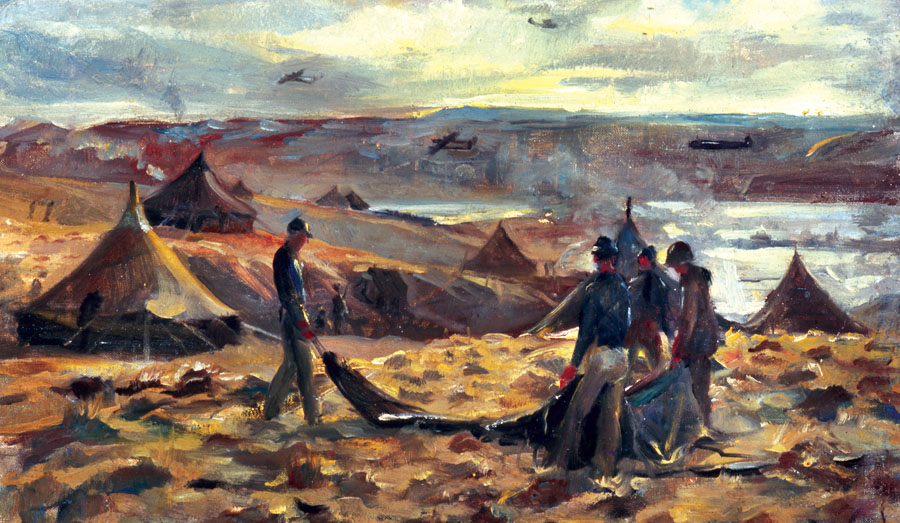
The initial plan was for a single regiment-sized unit with three battalions. It wasn’t long before these Naval Construction Battalions (or CBs) acquired the official name of “Seabees.” After some debate, the Seabee program was placed under the command of the Civil Engineering Corps.
Overall command was entrusted to a professional civil engineer, the same Admiral Moreell, who had already begun recruiting construction workers for Iceland. He was an early advocate of the NCBs, and his men would soon be calling him the “King Bee.”
Moreell expanded his efforts to recruit men from the building trades. Construction engineers would become commissioned officers while foremen and supervisors were enlisted as petty officers.
Fortuitously, many of the early Seabees had learned their trade skills in the New Deal work programs established during the Depression. One of these programs, the National Youth Administration (NYA), continued to help.
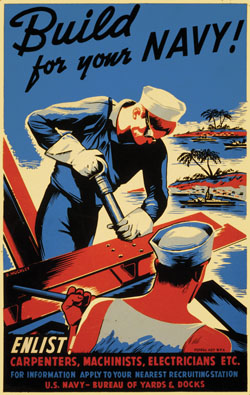
The NYA had built youth camps across the country that were no longer in use. These were made available to the Seabees to assemble, orient, outfit, inoculate, and provide some physical conditioning for the new recruits before hurriedly shipping them out to the South Pacific. Some of these camps were put to use until the Seabees’ own camps were built.
To appease the labor unions that feared the Seabees would be in competition with them, Moreell promised that the Seabees would only work overseas except in the case of national emergencies. As it was, nearly 80 percent of the early Seabees were union members.
Construction was only part of the job for the Seabees. The other part of their duty was as combat soldiers, so they were trained in the use of small arms and military tactics. When trouble came, they were expected to drop their tools and pick up their guns.
This led to the creation of the Seabees’ motto: Construimus Batuimus—Latin for “We build. We fight.” Their slogan became “Can do!” Around the same time the iconic insignia of the Seabees was created. It featured a bee wearing a Navy hat while carrying a tommy gun, a hammer, and a wrench.
Even before the bases could be completed or the chain of command established, the 200 men who had been recruited to work in Iceland were joined by another 100 raw recruits. They were given three quick weeks of basic training, and in January 1942 they boarded ship along with 4,000 regular U.S. Army troops of the 13th Coast Artillery.
Their convoy made two stops to load equipment and supplies in five transport ships before steaming with its escorts to the French island of Bora Bora, where it arrived on February 17, 1942. The newly arrived Seabees became known as the 1st Construction Battalion Detachment and for the rest of the war called themselves the “Bobcats,” after the naval code name for Bora Bora. Their assignment was to construct a major air and sea refueling base for warships keeping the vital sea lanes open to Australia.
The Bobcats started with nothing. Their construction and moving equipment rested at the bottom of the supply ship holds. Ship’s cranes could lower cargo onto barges, but when the barges reached shore unloading them had to be done by hand.
The land-based cranes, bulldozers, and earthmovers were buried beneath everything else aboard the ships. So eight 7-inch, 13-ton naval guns meant for the island’s defense had to be laboriously hoisted into position by hand. (Some of these guns still remain on Bora Bora today). It would take 52 days to completely unload the five transports and the three additional ships that arrived soon after.
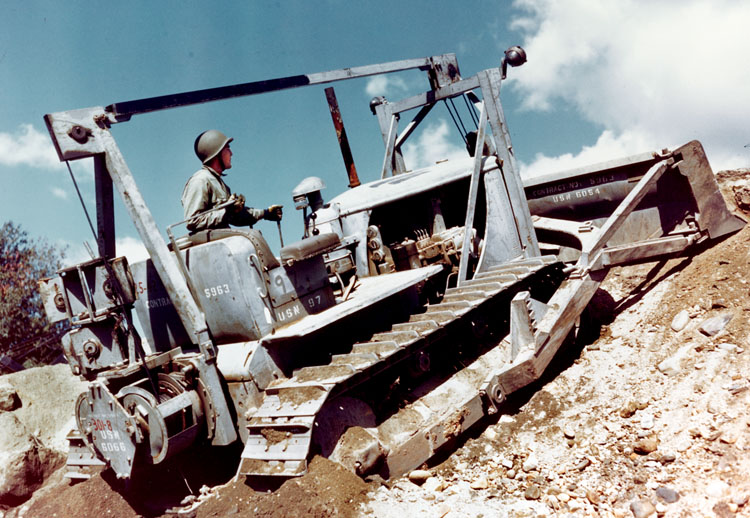
The men were subject to tropical diseases that sapped their strength. A few came down with the grotesque elephantiasis. Most of their food came from tins of questionable age. They endured incessant rain and mud with primitive facilities they had to build themselves.
Despite all obstacles, the Bobcats managed to set up 300 Quonset huts within three weeks. They built an airfield, docks, a power plant, and the all-important fuel tanks. To meet the Navy’s deadline for the fuel tanks, the 4,000 Army troops pitched in to help. Tankers brought in fuel as the men ashore worked long hours to position and assemble the holding tanks. The refueling station was up and running just in time to replenish the ships and planes that took part in the critical Battle of the Coral Sea in May 1942.
The Navy could not have fought in the Coral Sea without refueling at Bora Bora. For the first—but not the last—time, the enemy was surprised and confounded by the work of the Seabees. They and their Army partners were the unsung heroes of that battle. It had been hard work, and sometimes tempers flared. Their commander later wrote that his men “smelled like goats, lived like dogs, and worked like horses.”
Valuable logistics lessons were learned at Bora Bora. The Bobcats had been sent wheelbarrows without wheels. There were not enough spare parts for their trucks, and welding equipment arrived without protective masks.
Learning that civilians had done the loading of the transports that had caused so much trouble, the Seabees began to rely on themselves for loading and unloading the supply ships. Attention was given to what was being sent and the order in which equipment and supplies were needed ashore. They did such a good job that the Navy tasked them with the loading and unloading of all supply ships.
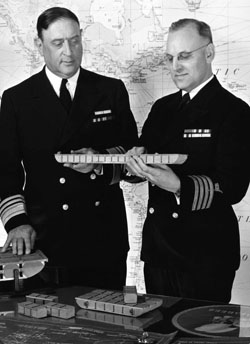
Back in the United States, Seabee recruiters continued to go after men with construction skills, but standards for physical fitness were relaxed. As a result the average age of the early enlistees was 37, and in some cases men in their 60s signed up.
In March, the 1st NCB shipped out to the islands of Tongatabu in the Tonga group and Efate in the New Hebrides. In May, the 2nd NCB arrived in Samoa. The 3rd NCB was sent to Fiji and Noumea in New Caledonia, the 4th to Alaska, and the 5th sent detachments to Midway, Palmyra, Johnston Island, and French Frigate Shoals. The Seabees began to build a ring of bases around the Japanese Pacific Ocean empire.
A detachment of the 1st NCB landed on Efate on May 4 to find a small group of Marines and Army engineers struggling to build an airfield. Delighted to see the newcomers, the soldiers and Marines gave pride of place to the Seabees for leadership. All three groups pooled their equipment and resources to complete the airstrip for the arrival of 20 planes on May 28.
High on the priority list at Efate was the construction of a 600-bed hospital. Lt. Cmdr. Samuel Mathis of the 1st Battalion explained, “We couldn’t start a land offensive until we had the hospital ready.” At the height of the battle for Guadalcanal, the hospital would care for 900 wounded men.
Along with their other jobs, the Seabees built a seaplane ramp so that on June 1 Consolidated PBY Catalina flying boats from Efate dropped the first bombs on the Japanese airfield under construction on Guadalcanal. But it was a 1,400-mile round trip to Guadalcanal; effective bombing could not take place from that range. The Seabees were ordered to move northward 200 miles to Espiritu Santo.
Lieutenant Commander Mathis remembered, “We arrived at Espiritu Santo on July 8 [1942]. There wasn’t a damn thing there but jungle.” They went to work immediately setting up generators and floodlights so they could work all night. Working around the clock, they built airfields, fuel tanks, barracks, and hospitals. In doing so, they decreased the range for bombing of Guadalcanal. The first fighter planes arrived on July 28 and Boeing B-17 Flying Fortess bombers the next day.
The 6th NCB was the first to come under fire. On August 7, 1942, the Marines landed on Guadalcanal to find an unfinished muddy, undrained, and unpaved airstrip that the Japanese had hastily evacuated. The airstrip had deep ruts from bombs and shells; more planes were lost to accidents in the chaotic sludge than in combat. Few Marines could be spared to work on the airstrip yet. To sustain themselves on the contested island, they needed working airfields. Call in the Seabees.
On August 20, Lt. Cmdr. Paul Blundon, CEC, USNR, commander of the 6th NCB, flew to Guadalcanal in a PBY to examine the unfinished field. He immediately called upon Maj. Gen. Alexander A. Vandegrift, the commander of the 1st Marine Division.
Blundon claimed that the Seabees could create an all-weather, paved airfield; Vandegrift was eager for the result but not so much in having more mouths to feed. His food supplies were limited and dwindling, and the available shipping to bring in men and construction equipment was problematic.
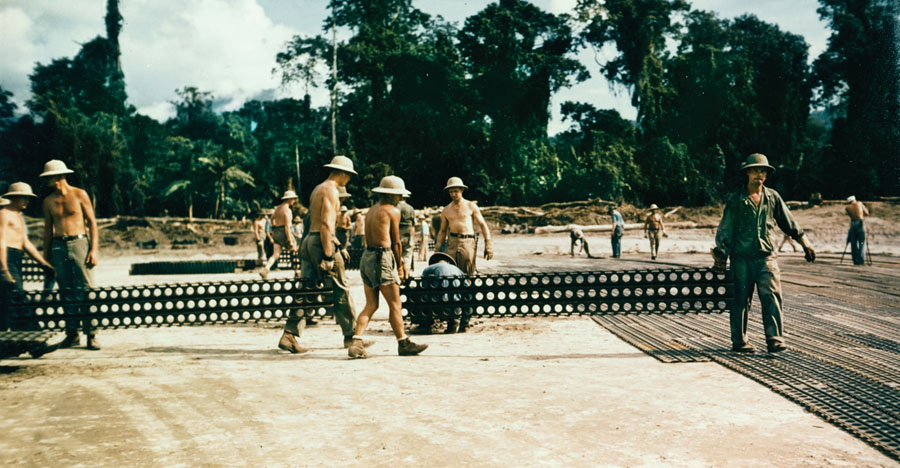
A compromise was reached in which only half the battalion would work on Guadalcanal until supply limitations were resolved. On September 1, five officers and 357 men of Companies A and B of the 6th Battalion landed on the island.
The Marines looked askance at the Seabees; some of them were old enough to be their fathers, and they wore a hybrid uniform with Navy, Marine, and Army influences. But the newcomers soon proved their worth.
After a rough first night on open ground, the Seabees went to work. First they would solve the drainage problem, then level, lengthen, and widen the airfield that was named Henderson Field by the Marines, after Major Lofton Henderson, who was killed during the Battle of Midway. They would also build two supporting fields for fighter planes. It would be mid-October before all 1,000 men of the 6th NCB were ashore.
Blundon recalled what was expected of the Seabees: “It was our job to keep the holes filled up while we finished the grading, laid Marston mat, built hardstands and revetments, and helped solve the fuel and ammunition problems.”
On their first day, the Seabees were greeted by a single Japanese bomber that dropped its payload near the airstrip. It interrupted but did not stop the work. Within three weeks the Seabees had drained and leveled the field. Next they began to pave the runway with newly arrived “Marston mat”—a 1/8-inch thick, perforated, and interlocking steel webbing that provided a level and firm foundation for landings, takeoffs, and taxiways.
As soon as the matting was in place, planes began to arrive to add their punch to the battle. It did not stop the Japanese, however. From the hills, the enemy could rain down artillery shells at will and at night nuisance bombers, nicknamed “Washing-Machine Willie” and “Louie and Louse,” dropped a small number of bombs on the airfields.
The enemy fire did not do much damage to the airfields, but it would compound the work of the Seabees. One day, in frustration, Seaman 2/C Lawrence Meyers grabbed a nearby .50-caliber machine gun and fought back—there were loud cheers when he shot down a Zero fighter. For his quick-thinking action, he would be awarded the Silver Star. Unfortunately, the honor would be posthumous; Meyers was killed in action two weeks later.
For three days in mid-October, the Japanese made a maximum effort to put the Americans out of business. Just before noon on the 13th, more than 25 Japanese bombers pockmarked the field, tearing up the Marston mat and leaving deep craters.
As the bombers departed, the Seabees rushed onto the field to repair the damage. Pre-loaded and positioned trucks brought loads of rock and gravel to fill in the craters. The damaged segments of the Marston mat were removed and replaced with new sections, which had also been prepositioned at the edge of the runway. Other Seabees gathered up and removed fragments of shrapnel and jagged steel pieces that could puncture airplane tires. The field was soon back in operation.
The bombing and repairing was repeated twice that afternoon after further attacks. Then at midnight, a Japanese battleship got close enough to pound the airfield with huge 14-inch shells. The seaborne bombardment was followed by another flight of bombers. Repair work went on throughout the night. Even the cooks pitched in to keep the airstrip open.
With unrelenting labor the Seabees had restored the entire field by 9:30 the next morning. The cycle of bombing and shelling, followed by repairs, lasted for 48 hours over three days. In all, 53 craters had pockmarked the field, but the Seabees, although exhausted and taking casualties, were equal to the task. On the other side, increasing aircraft losses forced the Japanese to cease their all-out effort.
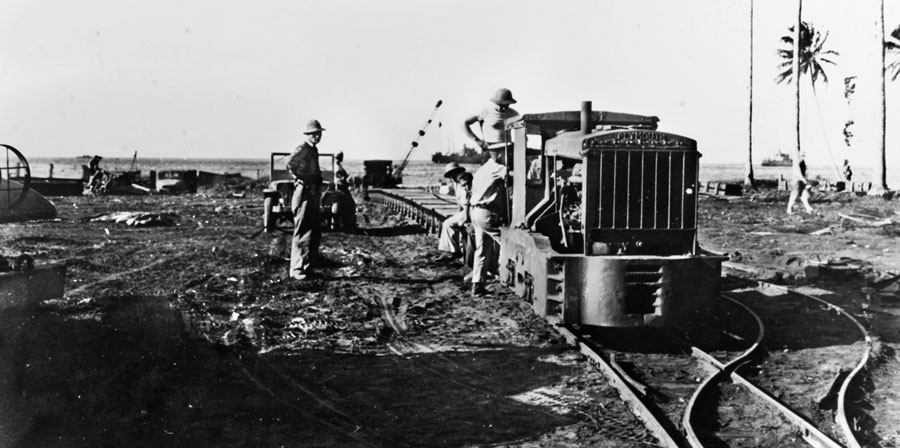
During the intense bombing, the American fighters were always able to get into the air. The trick was to have runway damage repaired before the aloft fighters ran out of gas. They sometimes had to circle Henderson Field while the Seabees labored as fast as they could.
Blundon later noted, “We found that 100 Seabees could repair the damage of a 500-pound bomb hit on an airstrip in 40 minutes.” After the worst was over, the Americans were still in the fight.
In addition to the desperate work of repairing the main airfield, the 6th NCB built 24 miles of road between the port, Henderson Field, and the two new outlying fighter fields. This included building several bridges to span intervening creeks and gullies. They restored a captured Japanese power plant to provide electricity. They also repaired a Japanese ice-making facility and dubbed it the “Tojo Ice Company.”
Detachments of the 6th NCB would also support the Marines on nearby Tulagi Island. The 6th was the first of four Seabee battalions to be awarded the Presidential Unit Citation.
In November, more Marines came ashore east of Henderson Field. With them were 500 men of the 14th NCB, who began building two dedicated bomber fields. In December, the 18th NCB arrived, followed by the 26th, which relieved the exhausted 6th which had borne the brunt of the Seabees’ battle for the island.
The late arrival of the Seabees at Guadalcanal convinced the Pentagon that, whenever possible, Seabees should land alongside the invasion force to begin their all-important work immediately. This gave rise to good-natured teasing between the Marines and Seabees. Each insisted that they arrived first and, in some cases, such as obstacle clearance, the Seabees did precede a Marine invasion. The Marines would be met with taunts like, “What kept you?”
In December 1942, the recruitment activity exercised by the Seabees was transferred to the Selective Service System. Thereafter recruitment came from the draft pool, but while candidates were younger and more physically fit their trade skills were limited. Theirs would be the ultimate “on-the-job training.”
Back in 1940, the legislation that enacted the Selective Service stated, “Any person, regardless of race or color … shall be afforded an opportunity to volunteer for … the land and naval forces of the United States.” Before the war, the limited number of African American naval personnel could only serve in the kitchen and dining rooms of officers as mess attendants. When the war began, thousands of black men signed up.
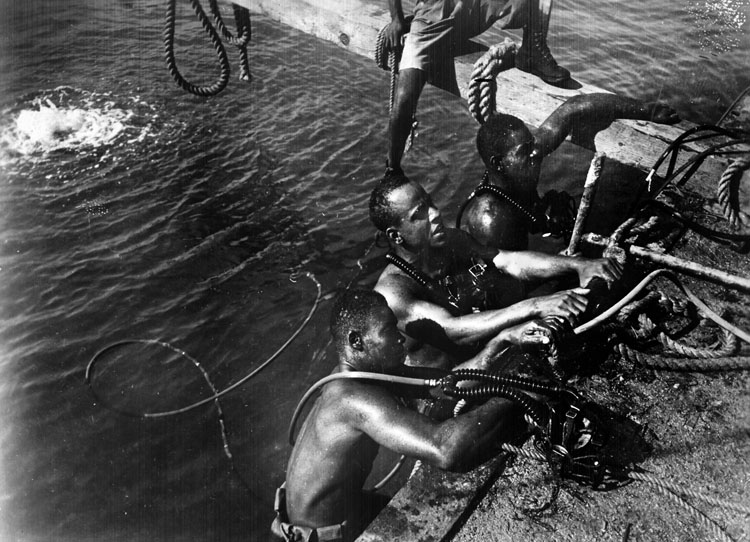
The military establishment in 1942 was still unprepared to place African Americans in fighting units. The Navy asked the Seabees to form battalions of these newly enlisted sailors to perform construction duties. By war’s end, some 12,500 black sailors had served in the Seabees. But there were compromises to be made.
Most of the black recruits hailed from the South, so it was thought prudent to place Southern white officers over them, the thinking being that they would know best how to deal with the Negros. But experience taught the Navy that this approach did not work and by 1944, these officers were replaced by more enlightened leaders. Promotions and commendations followed.
The first African American Seabee unit to be deployed was the 34th NCB. In January 1942, they shipped out for the South Pacific. For a year and a half they toiled in the sweltering tropics of the Solomon Islands. It would not be long before the war found them.
Aside from the casualties of accidents and diseases, five men were killed and 35 wounded from Japanese bombing. Around the time that the 34th shipped out, the second black battalion, the 80th, was being formed and would serve on the island of Trinidad. Others would follow.
As the war unfolded, the Japanese concocted a complicated plan to capture Midway Atoll in June 1942. It included a secondary invasion of the Aleutian Islands of Attu and Kiska. Suddenly, Alaska was on the front lines. Within a month, the 4th NCB arrived in Alaska to beef up the territory’s defenses. In August they were reinforced by the 21st NCB.
The work in Alaska included airport and facilities construction, fuel storage, barracks building, supply duties, and support for the Army in recapturing Attu and Kiska.
In August 1942, the 65th NCB landed near Freetown in what is now Sierra Leone, West Africa. The 65th shocked the complacent British colonials by reviving abandoned and rusted machinery and motivating native workers. Roads, airfields, and housing sprang up, the harbor was repaired, and the town was turned into a major supply base.
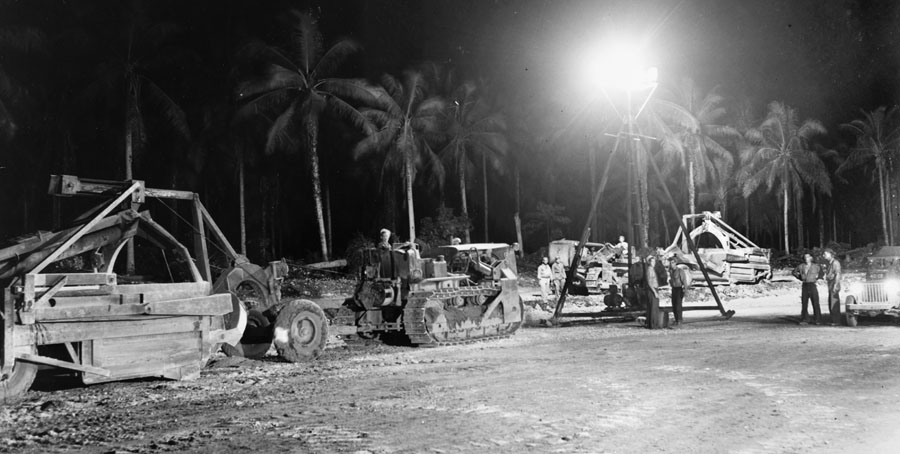
The invasion of North Africa opened a new front for the Seabees. Under the relentless desert heat and blowing sand, they unloaded and delivered supplies, expanded airfields and ports, improved roads and railroads, constructed barracks, built gun emplacements, and a thousand other things.
As wartime recruitment became standardized, so did basic training. The new Seabees would receive six weeks of instruction in unit training and the use of light arms. In all, 325,000 men and nearly 8,000 officers would train, build, and fight with the Seabee insignia on their uniforms.
In recognition of their courage, Seabees would earn 33 Silver Stars and five Navy Crosses, but the awards would come at a cost. Some 272 men and 18 officers would be killed in action, and 500 more would die in construction-related accidents or of diseases. Many more would be injured or wounded.
In the early days of the war, Seabees would arrive at their assigned location before their equipment could be shipped to them, so they had to improvise to get work done. One huge problem was that there were few functioning harbors or docks on undeveloped islands for unloading the supply ships. At one time there were more than 80 freighters swaying at anchor in the South Pacific, waiting to be offloaded.
On Funafuti in the Ellice Islands, an air raid alert sent a supply ship sailing away for safety, taking with it most of the food for Seabees. “We lived on Vienna sausage and hardtack for five weeks,” remembered one veteran.
Supply ships at Guadalcanal abruptly left when the enemy first approached. After the debacle of supply shortages there, “special” battalions of Seabee stevedores were created that worked exclusively unloading ships and distributing their contents.
Unloading would not cease just because ships came under attack. Instead of pulling up anchor and fleeing at the first sign of trouble, Seabees helped the understaffed crews man the guns, the infirmaries, and the engine rooms while continuing offloading operations.
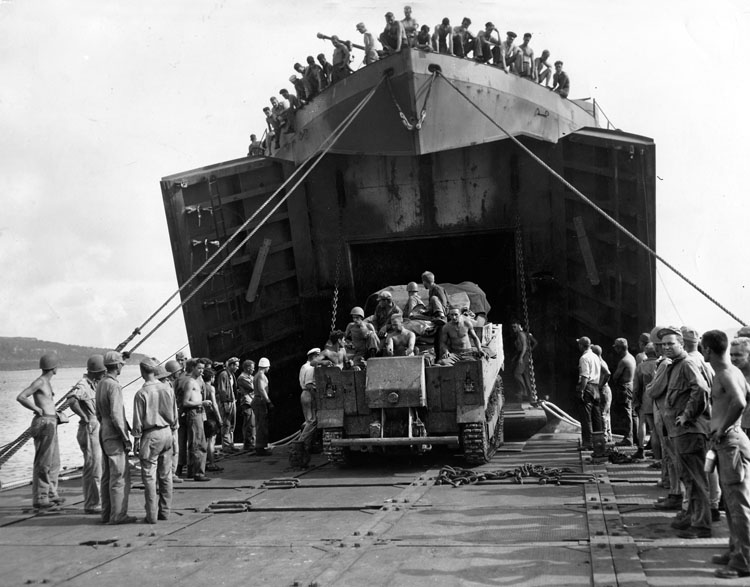
In the South Pacific, the Allies began to move up the Solomon Island chain. On the list was Vangunu Island in the New Georgia group. The Marines landed at 10:30 on the morning of June 30, 1943, followed closely by the men and equipment of the 47th NCB.
By 3 pm the beachhead was secure enough that the Seabees were able to begin construction of a fighter airstrip. Hills were blasted and bulldozed, ravines were filled in, leveled, and paved with crushed coral; nine days later the first plane landed. By July 18, a 3,300-foot-runway accommodated an entire fighter squadron.
During August the Vangunu runway was widened. Two large aviation fuel tanks were installed nearby, and support buildings and revetments were constructed, allowing bombers flying northward from Guadalcanal to have a fighter escort on their bombing runs.
The Seabees were needed not only in the Pacific, but also throughout the world wherever U.S. forces operated. In a two-ocean war, the Panama Canal was an extremely strategic location, so a ring of bases was built up to protect it. This included the expansion of existing facilities in the Canal Zone, Cuba, and Puerto Rico.
Agreements were made with Central American countries and arrangements made with the British on Lend-Lease territories in the Caribbean. Much of the early work was conducted by civilian labor, but by 1943 the rapidly expanding Seabee program enabled them to take over these jobs.
Back in the Solomons in late 1943, the 87th NCB was assigned the invasion of the Treasury Islands and would support combat troops from New Zealand. While driving his bulldozer ashore to commence work, Machinist’s Mate 2/C Aurelio Tassone was told that a Japanese pillbox was holding up the advance of the Kiwis and was asked if he could use his dozer to attack the pillbox.
He swung behind the enemy position and raised the dozer’s blade as a shield against rifle fire. When he reached the enemy position, he lowered the blade and stove in the palm log and sand barrier, entombing a dozen Japanese soldiers in the process. For his actions, Tassone was awarded the Silver Star. He also inspired a scene in the 1944 movie The Fighting Seabeesin which 37-year-old John Wayne reenacted Tassone’s heroics.
Back home, the Seabees came up with an invention that would drastically alter the war. They improved an ancient tool, the pontoon bridge, with standardized watertight boxes. Each pontoon was 5’x7’x5’ of welded plate steel. This effort was led by Captain John Laycock of the Civil Engineering Corps (CEC), who had a working model of his pontoon capable of supporting 20 tons ready for testing even before Pearl Harbor.
This system would be used not only for bridges, but also piers, wharfs, causeways, small drydocks, and barges. In Alaska one of these sturdy pontoon barges was even used as an icebreaker. Dragged ashore, the pontoons would be repurposed for, among other things, bake ovens and griddles. The differing configurations were facilitated by standardizing the parts and fasteners (called jewels) that joined the floating boxes together.
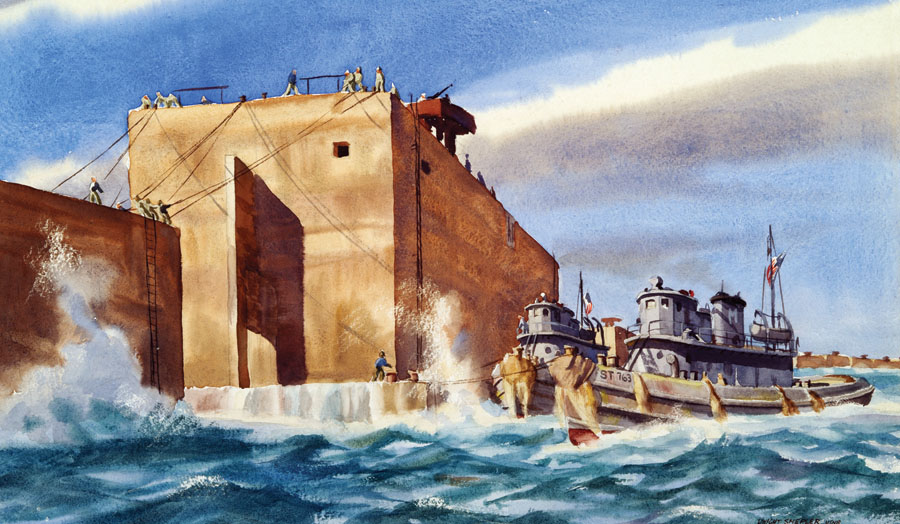
The first test of the new system would be Operation Husky—the invasion of Sicily—in July 1943. The waters around the southern Sicilian beaches were shallow, and LSTs (Landing Ship, Tank) would touch ground as far out as 500 feet and still be in six feet of water—not ideal for landing tanks or bulldozers.
The solution was a 300-foot pontoon causeway that would get the heavy equipment within 200 feet, wading distance of the shore. Top secret rehearsals helped make for a smooth landing. In all, 96 of these causeways, carried in sections by LSTs, were deployed. They would offload more than 10,000 heavy vehicles, trucks, guns, and tanks.
The enemy, believing amphibious landings in southern Sicily to be impossible, was caught totally by surprise. British Commander Lord Louis Mountbatten called the causeways nothing less than “miraculous.”
The Seabees tried to replicate their success on Sicily at Salerno and Anzio on the Italian coast but had lost the element of surprise—the Germans were not fooled twice. They targeted the causeways and the defenseless Seabees who rode them to shore.
When determined counterattacks threatened the beachhead at Anzio, the Seabees continued to deliver supplies and ammunition along the causeways while under fire, in the process suffering more casualties unloading the supply ships that stabilized the Allied positions and led to a breakout that eventually succeeded in capturing Rome.
With the lessons learned in North Africa, Sicily, and Italy, the Seabees turned their focus to the biggest engineering challenge of the war if not all of history: Operation Overlord—the June 1944 landings at Normandy, France. The Navy builders had already mastered the piers and causeways that would be needed. But there would be new challenges.
The coast of Normandy is often stormy in the spring, and 1944 was no exception. There were no harbors or breakwaters along the coast, so the Seabees determined to make them. The solution was a British invention called the Mulberry harbor.
The idea (Churchill’s) was to construct hollow blocks of cement caissons, called “Phoenixes,” that could be towed across theChannel and sunk side by side, with available “block ships,” to create a breakwater that would calm the sea enough to allow for the unloading of supplies over the now familiar pontoon causeways. The British-built caissons would serve both the British landing site at Gold Beach and the Americans at Omaha Beach. The task of constructing the American Mulberry harbor was given to the Seabees.
About 50 of the Phoenixes were used to create a two-mile-long Mulberry harbor at Omaha Beach. Each Phoenix was eased into place by British tug boats. Beginning on D-Day, the Omaha Mulberry took about a week to complete.
Another problem at Normandy was the unpredictable shoreline, which undulated in underwater ripples of sand bars parallel to the beach that could trap the large landing craft (LSTs) far offshore. The solution, based on the pontoon system, was barges consisting of joined pontoons 30 boxes long and six wide. It was called the Rhino Ferry.
The Rhinos would dock with an LST in deep water. The ship would then transfer half its cargo at a time onto the “ferry,” and two huge outboard motors would then power the barge to the shore. After unloading, the barges would return for the second half of the LST’s load.
The 81st and 111th NCBs––which had worked on the Italian landings–– were given the task of constructing, testing, and operating the Rhinos. On D-Day, 11 Rhinos would be employed in the first waves at Omaha Beach, growing to 20 as soon as possible; 11 more would be used at Utah Beach.
On June 5, LSTs began to pull the Rhinos out of British ports toward France. The going was slow in the choppy seas and took all night; it would be 5:30 am before they were in position. The Rhinos were designed to operate in waters with a three-foot swell, but the swells off Normandy that day were six feet and over.
It was dangerous work getting the rhinos lashed and secured to the front of their LSTs. Accidents slowed progress as Seabees and machine operators began loading 75 to 80 trucks, tanks, and bulldozers onto the barges in the heaving swells.
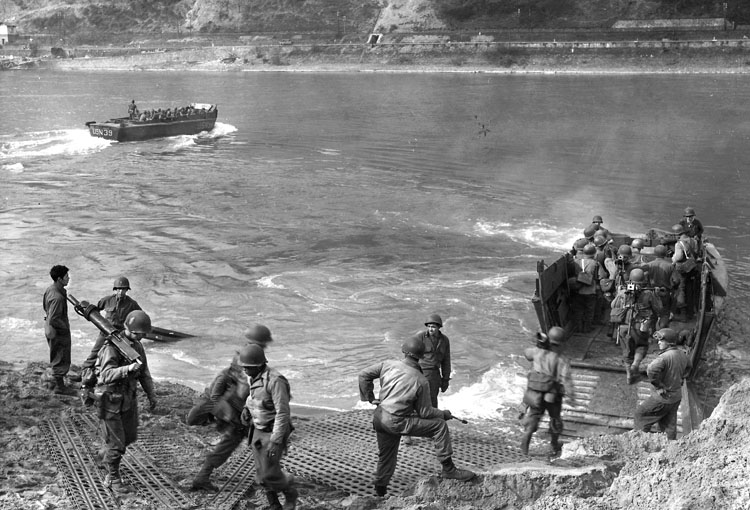
Even with the help of tug boats and small landing craft pushing from astern, it was noon before the first of the ferries reached shore at Utah Beach, much to the relief of all on board. At Omaha, meanwhile, the Rhinos were stopped before they could reach shore. German obstacles of steel, concrete, and mines–– not to mention sunken and disabled landing craft––stood in their way.
Only one Rhino, commanded by Lieutenant Robert Stilgenbauer, reached shore on D-Day, and that was because he failed to see the signal to stop. Somehow he made it through the obstacles to the beach and unloaded his cargo, but by the time he was through offloading the heavy vehicles, the tide had gone out, leaving him stranded on the beach until the tide returned. No other Rhino would land at Omaha until D-Day plus 1.
Before Stilgenbauer landed, the first Allied troops ashore were Seabees of Naval Combat Demolition units and soldiers of the Army Corps of Engineers. These men were trained demolition experts who worked as fast as they could in the growing light before dawn to remove the obstacles. When they were spotted by alert German sentries, they came under severe fire and suffered casualties. Still, they blew up enough of the obstacles to open up the beaches for the landing craft.
As Seabees were destroying obstacles ashore and wrestling with Rhinos at sea, about 10,000 more men of Naval Construction Regiment 25 (25th NCR), a temporary amalgamation of several battalions, were installing causeways and piers at Utah and Omaha Beaches.
While the Rhinos brought in the first wave of heavy vehicles, these causeways would, over time, deliver millions of tons of equipment and supplies of all types to the insatiable Allied armies until November 1944, when French and Dutch ports were retaken from the Germans. The Seabees were then tasked with obstacle removal and repair of those port facilities.
The Seabees’ dominion was the ocean shore, where they excelled at supporting and supplying the Army and Marines. There was one major exception.
When General George S. Patton’s Third Army reached the Rhine River, detachments of the 627th, 628th, and 629th Construction Battalion Maintenance Units (CBMU), wearing Army uniforms at Patton’s request so they would not be mistaken for the enemy, were on hand with small boats (300 in all), construction equipment, and the ubiquitous pontoons to ferry the soldiers, tanks, and supplies across the mighty river.
During the course of the war, the Seabees performed above and beyond the call of duty. At Guadalcanal, Seabee cooks fed every Marine that came to them as long as the food lasted. It became a sense of honor with the Seabees throughout the war to feed every sailor, Marine, soldier, or airman who asked.
In the Russell Islands north of Guadalcanal, one cook, a chef before the war, convinced the Navy to buy an entire herd of local cattle. Processing the meat and baking his own buns, he operated a hamburger stand, serving his Seabees and the island’s more numerous Air Corps personnel––all at no cost to his customers.
While the Army was still struggling on the beaches of Normandy, the 2nd and 4th Marine Divisions landed on Saipan on June 15. Landing with them were the 18th and 121st NCBs. On June 19, the Marines captured Aslito airfield and turned it over to the Seabees, who hurriedly filled in bomb craters, removed shrapnel and debris, and smoothed over the mile-long runway so that the first American plane could land there just two days later.
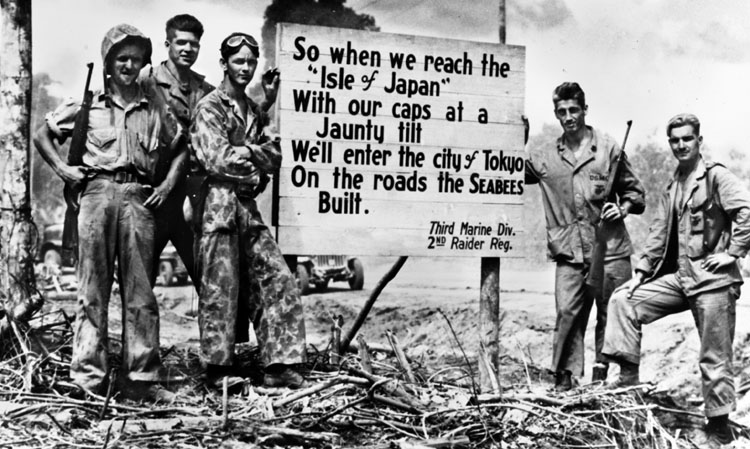
At Saipan, as everywhere else, the Seabees did more. There was a small wrecked Japanese railroad that ran from the shore to the airport. The construction men restored the bombed-out rail bed and track while repairing the locomotive and cars.
The task took four days, and then the train carried everything from bombs to fuel from the landing site to the airfield, much to the relief of the men who would have had to haul it by hand otherwise.
The next American target was Guam. On July 21, the 3rd Marine Division and the 1st Marine Brigade waded ashore, followed closely by the 25th NCB. The Seabees immediately began unloading cargo, sorting it out, and moving it across the beach to the intended units.
The 25th had the support of the 2nd Special Battalion. The Seabees had created several of these “specials” for specific tasks, such as stevedores, demolition, and ordnance clearance, road building, lumberjacking and milling, machine repair, maintenance, and more. The 2nd was recruited from among stevedores and dockworkers as experts at loading and rapid unloading of cargo.
At a second landing site on Guam, Seabees, driving a waterproof tractor, assisted with unloading LSTs stuck on a reef. They then guided tanks through the shallowest water to reach the shore while under fire.
By the end of the first week of the invasion, Seabees were at work improving Apra Harbor, the only natural harbor on the island. Despite all their work being destroyed by a typhoon in October, they redoubled their efforts to make Apra a first-class harbor.
Next came the invasion of the nearby island of Tinian, three miles south of Saipan. There was only one beach on Tinian, and it was heavily defended; the rest of the island contained natural obstacles like cliffs and swamps.
On the north shore of Tinian were 15-foot cliffs that the enemy considered unassailable; they didn’t think about the Seabees. Captain Paul Halloran, a civil engineer who commanded the 6th Construction Brigade, designed a special device for an LVT (Landing Vehicle, Tracked) that carried a ramp with cross ties.
Upon reaching the shore, the LVTs (affectionately called Doodlebugs) dropped their ramps against the cliffs and rolled over them to reach the top. While the Japanese waited in the south, the 4th Marines scrambled over the northern bluffs and outflanked them. The July 24 invasion was all over by August 1.
The Seabees were nothing if not anxious. In the midst of several battles, Seabees could be found surveying and mapping areas still under enemy control. On Guadalcanal, they had to be told to stop using dynamite close to the front lines because it disturbed the target alignment of artillery pieces.
On Tinian, Captain Halloran led a crew to survey a site for a runway. One of the Seabees noticed that several Marine tanks were pointing their guns at them. When the officer went to investigate, a tank officer told him that they had not taken that ground yet and to leave and come back in a few hours. The situation led to more humor about who arrived first.
After the enemy was cleared out, the Seabees went to work on what would become the largest airport in the world. Six separate runways had to be cut and filled, scraped and leveled, surfaced and maintained. Each one was at least a mile and a half long and a city block wide.
Two hundred dump trucks worked 20 hours a day (two 10-hour shifts), followed by four hours of maintenance. The airfields were built to accommodate the huge Boeing B-29 Superfortress bombers that were arriving to bomb Japan into submission.
The Seabees created housing, kitchens, hospitals, water storage, fuel and ammunition dumps, and sanitation facilities for 40,000 men (15,000 of them were Seabees).
Perhaps for their own amusement, they laid out a street grid for Tinian that was patterned after the grid of Manhattan. An ammunition dump in the center of the island was known as “Central Park.” Even the streets were named after their counterparts on Manhattan. Tinian today still retains many of these New York street names.
A symbiotic relationship started to grow between the Seabees and some of the crews of the B-29s flying from the island. Some of the crews gave their planes Seabee-inspired names, and these airmen were taken under the wing of the Seabees. They began to receive preferential housing, more comfortable bedding, ice cream upon returning from a mission, and other signs of favor.
The landings at Leyte Gulf in the Philippines were an Army show, but as in Europe the Seabees were crucial to their success. The Sixth Army roared ashore on October 20. The Seabees were prepared to support them with pontoon causeways and landing boats, but they were not needed. The sheltered gulf and sandy shore provided perfect conditions for the large LSTs to land at the shoreline.
Only an hour after the initial landings, the Seabees went to work unloading the LSTs and distributing the vehicles, equipment, and supplies carried in their hulls. The construction battalions soon would be needed for other work.
On the night of the 24th, Admiral William Halsey steamed with his entire Third Fleet northward to intercept approaching Japanese aircraft carriers, leaving the Army without fighter cover. The 61st NCB and Army engineers rushed to complete fighter and bomber fields to protect the vulnerable troops.
About 32,000 Seabees served in the Leyte-Samar campaign. Their building projects and shore facilities came under Japanese air attack a total of 100 times. On one occasion Japanese troops parachuted onto an airfield construction site on Samar. The Seabees held them off until Army troops could arrive.
Near Manila the 119th NCB built a camp and hospital for 4,000 liberated American POWs. Many were malnourished and had suffered mistreatment. At the camp they were housed and fed, their wounds and sicknesses cared for until they could be shipped home.
Halfway between Tinian and Japan is the rocky outcrop of Iwo Jima. The assault on the little island was to be spearheaded by the 4th Marine Division supported by the 133rd NCB consisting of 23 officers and 767 men. Battle plans called for a campaign of three days. It would take 29 days.
On February 19, 1945, the Seabees landed on the beach just 20 minutes after the initial Marine assault wave. The construction battalion was initially used as a shore party, hauling supplies and ordnance to the front.
The soft sands of the beaches would not support wheeled vehicles, so tanks and bulldozers were enlisted to haul trucks to the solid ground behind the beach sand, all the while coming under fire from enemy artillery and snipers. When Marston mats were brought ashore, they were laid down so that trucks could negotiate the treacherous sands.
The main job of the 133rd NCB was to repair and upgrade Motoyama airfield located in the center of the island. The task had to be reassigned to the 31st and 62nd NCBs because, by the time the airfield was secured, the 133rd had suffered 328 casualties, including 42 killed and two missing. It would be the highest casualty count that any CB unit suffered.
While the fighting still raged, Seabees were building housing for the Army Air Forces, creating or improving harbor facilities, and bringing ashore the mountains of supplies, food, fuel, ammunition, building materials, and equipment needed for everyone involved—Marines, Seabees, and Army Air Forces.
Often working under fire, the Seabees were able to prepare the airfield for crippled B-29s returning from Japan even before the end of fighting on the island. Soon, two fighter fields were also constructed so that the huge bombers, flying from Tinian, would have fighter protection as they approached their targets.
At a press conference, Admiral Halsey, speaking of the three airfields, said of the Seabees on Iwo Jima, “If necessary, they’ll build another island and put four or five airfields there.”
In the Pacific, the most difficult task the Seabees faced was Okinawa. The island invasion was entrusted to the Tenth Army and a corps of Marines. In support would be an initial force of 16,000 Seabees and Army engineers.
Seabee battalions were organized into 11 regiments and four brigades, under the command of Commodore Andrew G. Bisset. His command included U.S. Army and even some British engineers. Once the island was secure, he would oversee the activities of 95,000 construction troops. It was the largest gathering of builders for a single battle in the war.
By this point, amphibious landings were well rehearsed. After a brutal naval and air bombardment, LSTs hauled segments of 25 individual pontoon causeways that were laid down between the coral reef and the shore.
Three battalions of Seabees landed to act as shore parties unloading the immense amount of matériel needed to sustain the combat troops. Other Seabees cleared mines and obstacles while the first airfield captured by the Army was turned over to the Seabees and the Corps of Engineers, who had it operational on D-day + 3.
As elsewhere, surveyors often went out in front of the fighting troops and located sites for barracks, fuel storage, and much else before the ground had been taken. When the island was secure, the Seabees built it up as the main base for the planned invasion of Japan. Airfields capable of supporting 4,000 fighter, bomber, cargo, and reconnaissance planes had not yet been completed before the Japanese surrendered. That didn’t stop the builders. They finished their tasks on Okinawa—and they weren’t done yet.
Seabees were among the first Americans to land in Japan after the cessation of hostilities. There they cleared away damage and created barracks, kitchens, and mess halls for the occupation troops that were to follow. So valuable had the Seabees been to the war effort that the Navy was determined to retain them as a fully equal branch.
The Seabees’ record is truly remarkable. As an exhibit at the Seabees Museum in Port Hueneme, California, says, “Throughout the Pacific Theater, the Seabees built 111 major airstrips, 441 piers, 2,558 ammunition magazines, 700 square blocks of warehouses, hospitals to serve 70,000 patients, tanks for the storage of 100,000,000 gallons of gasoline, and housing for 1,500,000 men.”
It should also be noted that the Pacific Seabees suffered more than 200 combat deaths and earned more than 2,000 Purple Heart medals.
Many of the facilities the Seabees built more than 70 years ago are still in operation. As just one example, Henderson Field on Guadalcanal is now Honiara International Airport, the Solomon Islands’ main airport.
Today, the Seabees are still active, deploying to war-torn trouble spots and the sites of natural disasters. Following the hurricanes of 2017, Seabees were deployed to Puerto Rico and the Virgin Islands to assist with cleanup, water and food distribution and rebuilding. They continue to fulfill their commitment to the Navy and the nation.
